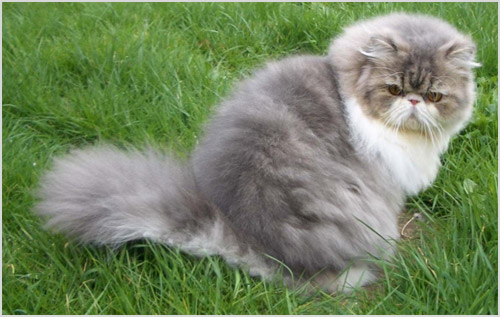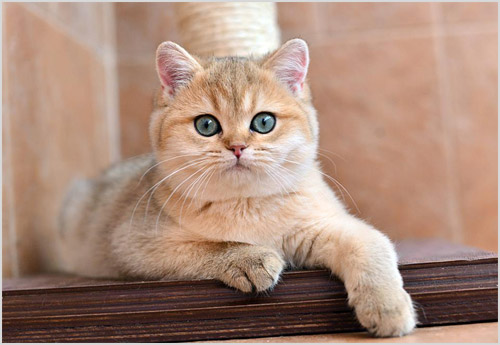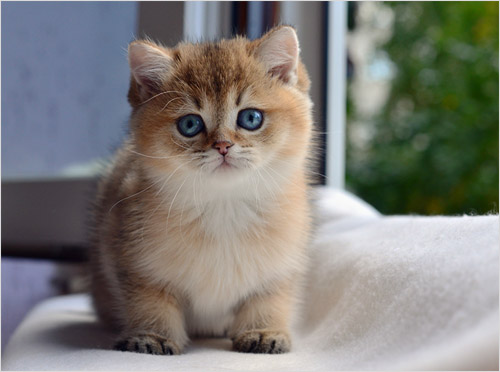One of the most aristocratic breeds - chinchilla - has been admiring cat lovers for more than a hundred years. These are incredible fluffy beauties with emerald, copper, golden eyes.
History of the breed
The history of Chinchilla begins in the 80s of the 19th century with a cat named Chinnie. The researchers suggest that it was darker than the modern representatives of this breed, and her hair was painted only by 1/3. For her they found a cat, a suitable color, from the mating with which it was possible to get two litters of silvery kittens. According to the memoirs of contemporaries, 2 cats were very good, which were often exhibited, but they had no offspring. Continued the genus Chinchilla cat Beauty. Her kitten became the first representative of the breed of Chinchilla.
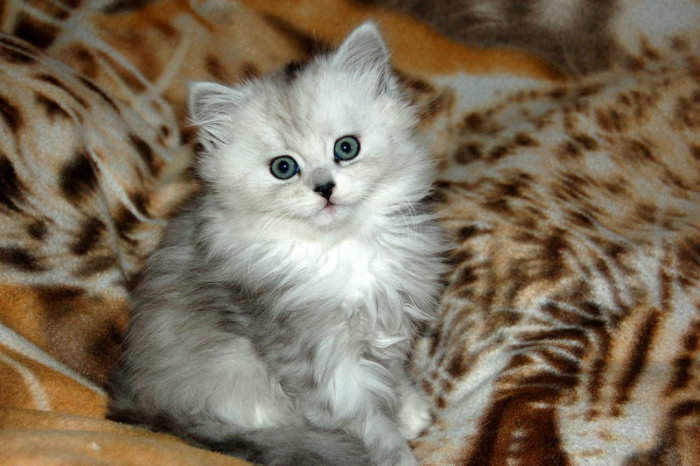
Back in the 20s of the 20th century this breed was very small, and crossing was conducted with other thoroughbred cats of smoky, blue color and silver tabby. Only in the mid-30's there was a sufficient number of chinchillas to continue working on color. Thus, the color of Chinchilla became the first color that was consciously created and fixed by the breeders.

CFA Standard
The variety of species of this breed (British, exotic, Persian) and their colors complicated the standardization, therefore the parameters characteristic of any varieties of chinchilla are most often determined:
- All lines of the body and head should be soft and rounded
- Size, weight. Cats are much larger and reach 7 kg. Pussies are more fragile and elegant, their weight varies from 3, 5 to 4.5 kg.
- Head round, small, skull convex, well defined jaws
- Ears with rounded tips are low set, widely spaced from each other
- Eyes large with dark fringing, widely planted. Their color should be intense, bright in tone to the color of the animal
- The nose is snub-nosed, short. Lilac from pale pink to brick-red depending on the color, surrounded by a border
- The body is squat, compact. The back is straight. Chest high and broad with a chic jabot
- Paws short, strong. Pillows are dark, between them are bundles of wool
- The tail is straight (without kinks), short. The wool on it should be longer than on other parts of the body
- Wool is thick, fluffy, long
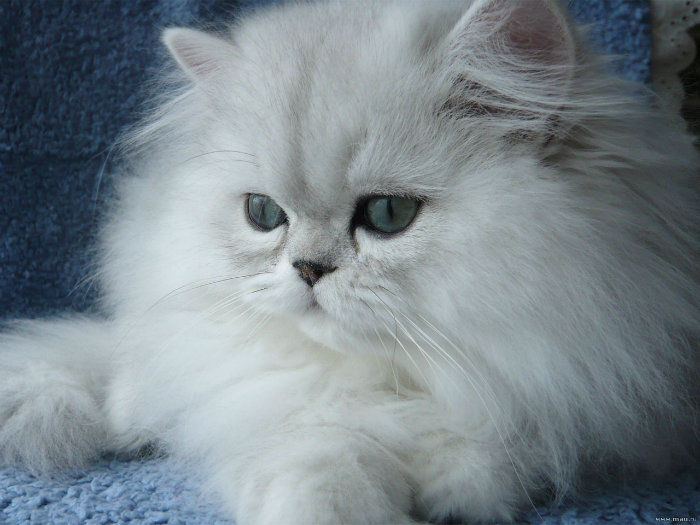
Color chinchillas
Black group: Chinchilla (silver), Chocolate chinchilla, Cinnamon chinchilla Diluted black colors: Chinchilla, Chinchilla Reindeer, Cinnamon chinchilla (not recognized by the standard)
Based on red: Red Chinchilla and Cream Chinchilla
Tortoiseshell: Silver tortoiseshell, Chocolate tortie, Cinnamon tortoise (not recognized by the standard)
Diluted tortoiseshell: Blue-cream tortie, Lilac-cream tortie, Cream tortoise deer (not recognized by the standard)
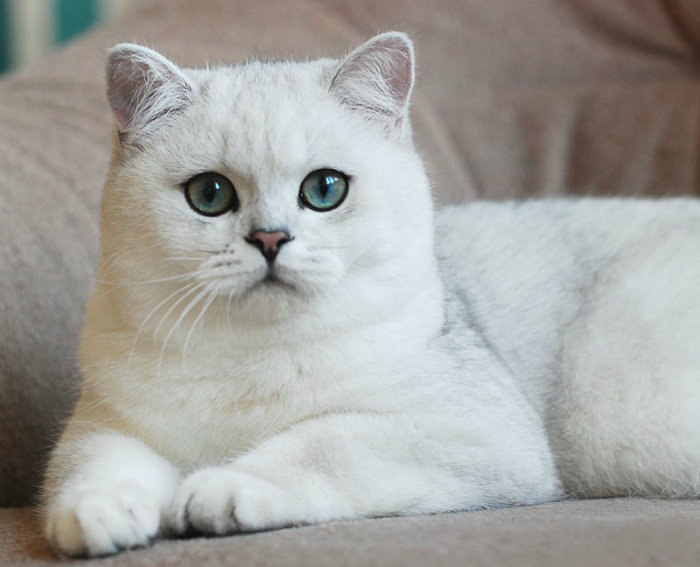
Defects leading to culling from breeding include:
- strabismus
- muzzle asymmetry
- tail fissures
- white spots on the chest, paws, in the groin
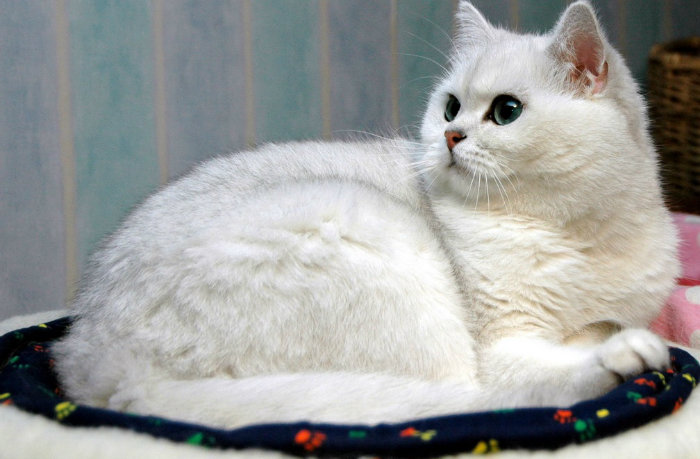
Character of chinchilla
Basically, they are calm, intelligent, accommodating cats. They are inquisitive and playful, not prone to escape and adventure. Their playfulness and desire to move should be maintained, since otherwise they will become rotten and will be lethargic and apathetic. Very attached to the owners, they love to be in the spotlight. Patiently treat children, but do not allow them too "free" behavior towards themselves. With other animals, they can get along, but they prefer to remain the only favorite in the family.
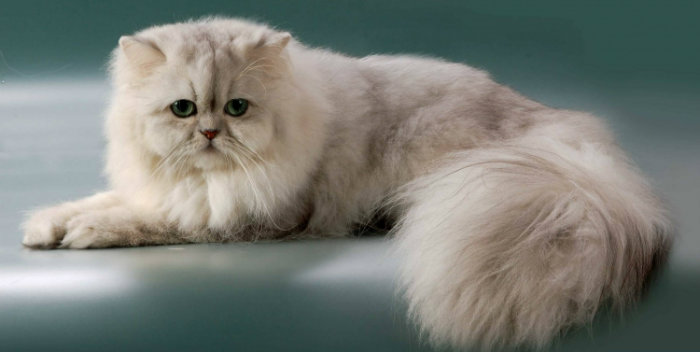
Like most longhair cats, chinchilla is demanding to care, especially for hair and eyes. She herself will not be able to properly care for her chic "coat" because of too short a tongue.
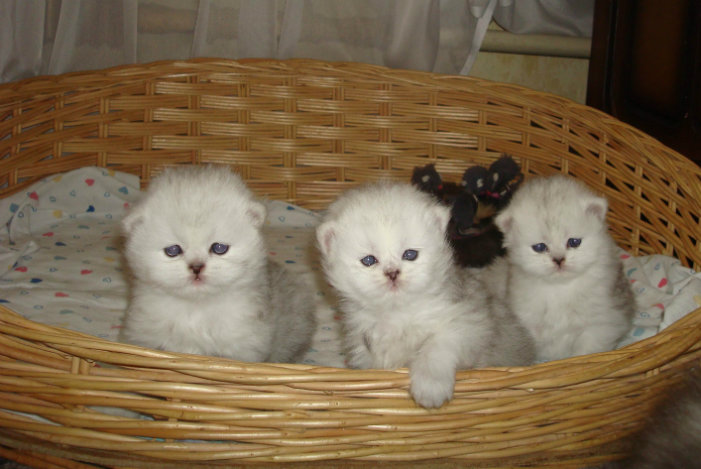
- Combing.
- with sparse teeth (to straighten the hairs)
- with frequent teeth (for combing the undercoat and dead wool)
To start combing, you need to comb the hair with a comb with sparse teeth. Then, first along the wool, and then against its growth pass a crest with frequent teeth. Cheeks and neck are recommended for combing in the direction of the muzzle.
IMPORTANT! Chinchillas are one of the few cats that tolerate combing well, but it is still recommended that they be taught this from a very young age.
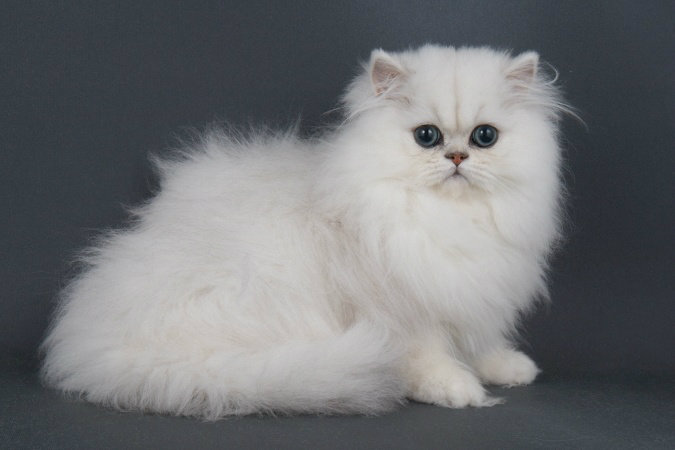
If the wool formed koltuny, they must be carefully cut.
When combing, you should not forget about the bunches of wool between the pads of the paws. Rolling, she will cause her inconvenience when walking.
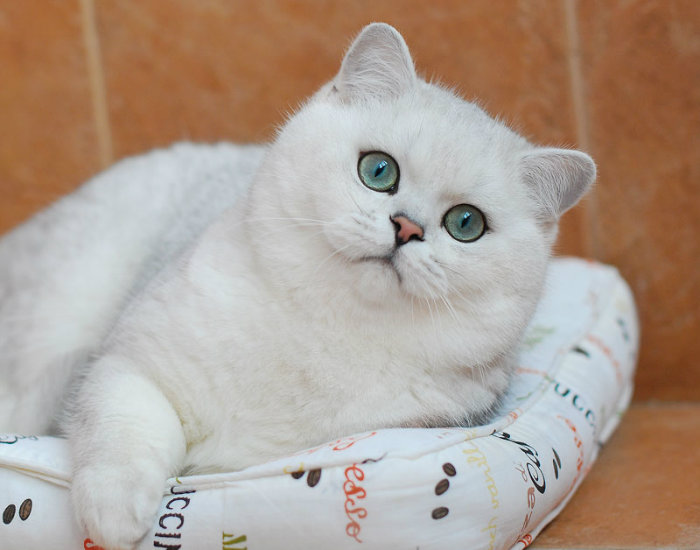
- Treatment with dry shampoo
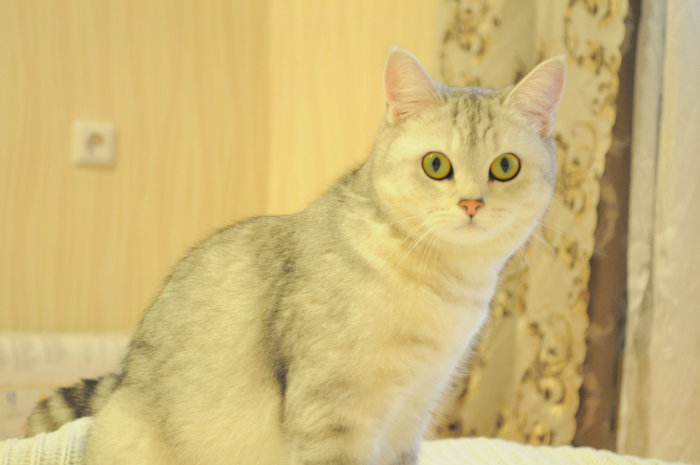
- Bathing
In general, they do not like swimming very much, so you need to be prepared for all kinds of unpleasant surprises.
During washing, make sure that water and foam do not get into the nose, ears or eyes of the cat.
![]()
- Hygiene
- auricle treatment 2 times a month
- daily eye treatment with special napkins
- clipping claws as needed.
- Prevention.
To prevent various diseases, they need vaccinations by age and deworming once every 3-4 months.
- Walking for chinchilla is optional. But if you take it outside, it is better to use a harness or let it out into a covered enclosure.
- Feeding
Should be balanced and carried out 2-3 times a day.
IMPORTANT! When feeding natural food, it is necessary to add a complex of vitamins and microelements to the pet's diet.
And when feeding with dry fodders, use the super-premium feed supplements, taking into account the physiological characteristics of the cat.
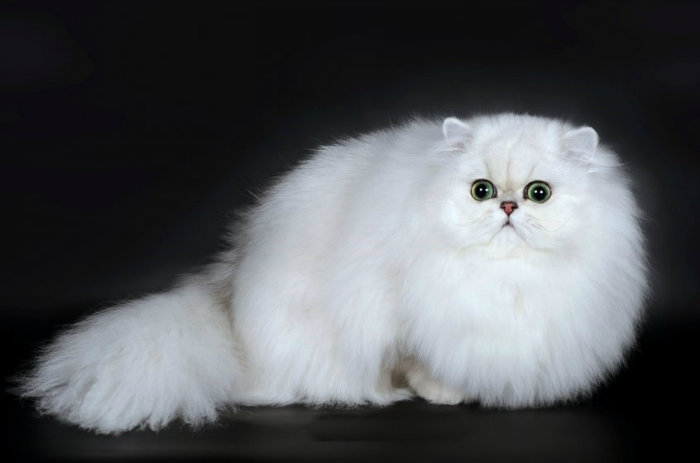
Health
It is believed that with good care and proper feeding, chinchillas will long please their owners.
But! This breed has a genetic predisposition to the following diseases:
- polycystic kidney disease
- hypertrophied cardiomyopathy
- retinal atrophy
- obesity
It should be remembered that they may have problems with breathing (especially in hot and dry weather) due to the specific structure of the nasal sinuses and eye (profuse tearing) due to poorly formed lacrimal ducts. Also quite often arise problems with teeth and skin diseases.
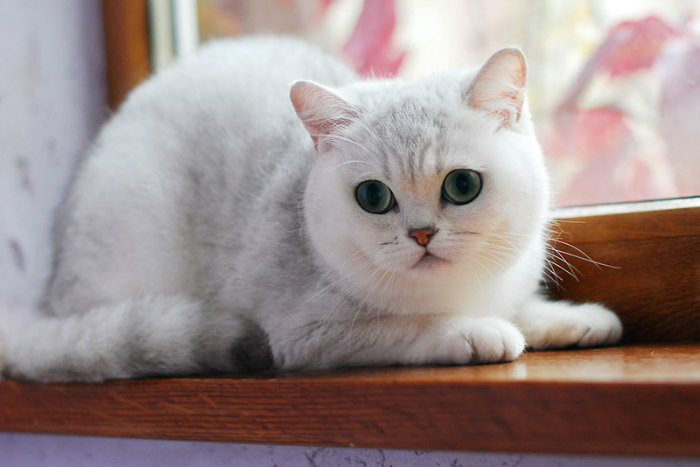
IMPORTANT! If an animal has any symptoms of a disease, you need to contact the veterinarian. Self-medication is dangerous for the life of your pet!
The world is full of beautiful cats, but one of the most exquisite breeds is the British chinchilla. Their meek, but open look and plush coat conquer instantly. However, a cat requires not only love, but also care. In terms of content, this breed is very capricious. What other features and surprises are hidden in the British chinchilla?
History of the origin of the breed
The history of British cats of chinchillas began in the distant 1882. In one English nursery, a lovely kitty Shinni was born. However, the cat itself is not popular - her son became legendary. He won awards and glorified the breed for many years, for which he was immortalized after death in the London Museum of Natural History. The British chinchilla was distinguished by a unique silvery hair, which flowed from light to dark gradient. It was this amazing color that spurred the specialists to deduce British chinchillas. Eventually, the kittens appeared white with a light color on the tips.
A great popularity of chinchillas was given by Princess Victoria. Cats became favorites for their wonderful character and sweet appearance, gaining recognition among the people. Everyone wanted to imitate the monarch's family, after which the British chinchilla migrated to other continents. In the CIS countries nurseries with such cats are few in each country. This is due not only to the high cost of chinchilla, but also to its exactingness. Such a cat needs good care.
British Chinchilla: Breed description
British chinchilla is a light kitten. He has widely planted and always large eyes of green or blue. Sometimes there are yellow-eyed black and dark smoky individuals. Around the eye of the chinchilla is a dark rim. Head round, slightly convex. The neck is thick. The nose of the chinchilla is short and wide, rather snub nose. The cat has a powerful jaw and small ears, with rounded tips.
Important! The British chinchilla has a very thick coat, which must be carefully taken care of.
Such cats always have a large body with developed muscles. Short paws make it squat. The cat's coat is light, but the legs and nose are darkened. Color can range from black to purple. The chest is wide, and the back is even. Between the fingers of the paws, the British grow their wool. The tail is short and thick.
The breed of cats British chinchilla is diverse in color:
- classical silver;
- gold;
- cream;
- ticking;
- tabby;
- marble;
- bicolor;
- turtle;
- harlequin;
- faun.
The back of the chinchilla, the sides and tail, is always darker than the basic tone. The males have such expressive cheeks that they can be distinguished from the first sight. There is a British shorthair chinchilla and long-haired.
Royal manners of British aristocrats
Chinchillas kittens are very tactful. They never wake up the masters in the morning, preferring to wait for their awakening. Even in small kittens, there is already a clear English calm.
It is interesting! British chinchilla is easy to teach the daily routine.
Adult individuals are very capable. They all demonstrate the nobility of the breed. The British chinchillas are very smart. These cats have a good intelligence, like to "talk" with the owners. Their vocabulary is short ("meow" and "moor"), but the ability to make intonational accents is amazing. They never allow to violate their personal space: they pat themselves, but they will not be able to cuddle. These British are very stubborn. Activity and curiosity are always in moderation.
The British chinchilla cat is attached to one master and loves it faithfully. However, even the entreaties of the beloved master will not help if the cat does not want to do anything. Such cats love to tell the owner about their affairs. According to the tone of the voice, you can determine in what mood the pet - so masterfully they get to express their emotions.
Important! Only caress you can achieve something from these aristocratic British.
With children, chinchillas are patient. Such a cat will never expose fangs or claws on a child, only run away to where it is quieter. To the guests the British silver chinchilla is intelligent, but without interest. He will not tolerate the humiliation of his dignity.
Even a silver chinchilla cat can get along with other animals. They are not afraid of loneliness, but they do not like it when the owners of the house do not pay attention to them.
In a healthy body healthy mind
British chinchillas often have problems with the eyes and teeth. It is necessary to clean them periodically, in order to preserve the health of your pet. Caries at the cat also need to be treated. Among the serious diseases to which chinchillas are exposed, there are pathologies of the kidneys, liver and heart.
Note! British chinchillas are excellent health.
Kittens of chinchilla should be vaccinated against rhinotracheitis, calicivirosis, plague, rabies. Today, one injection is enough to save the cat from many problems, because the vaccine is complex. After a while, the vaccine should be repeated. This helps to consolidate the effect. Regular preventive injections need to be done every year. Most drugs are carried by animals without consequences. It is advisable to contact one veterinarian so that he knows the history of your British.
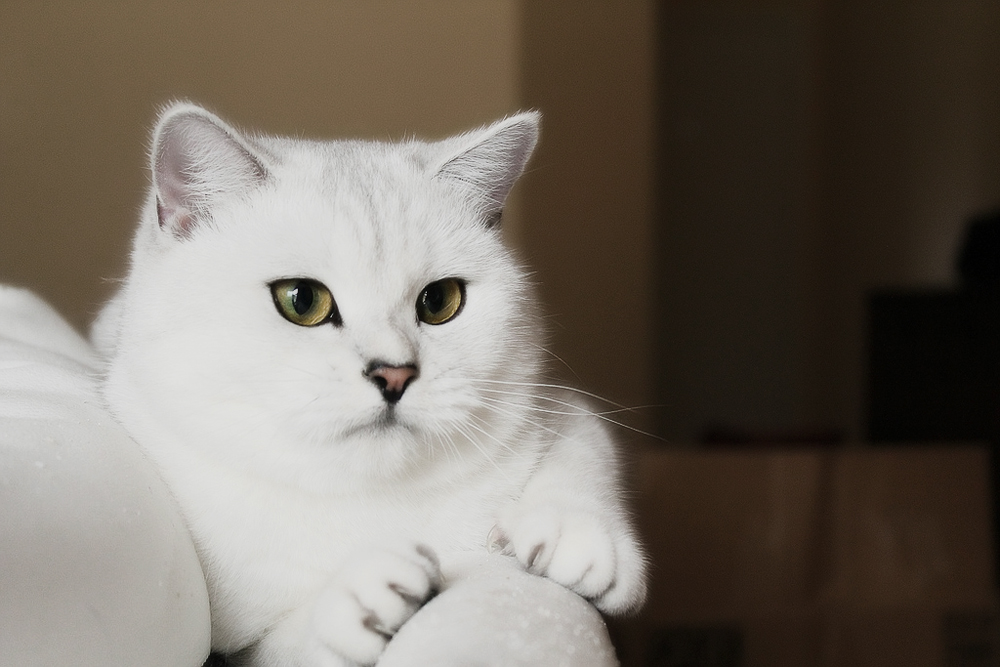
A lovely and well-mannered kitty will decorate any house. Regardless of the order of the family, the British chinchilla will be able to adapt, bringing joy.
When mentioning silver chinchilla many imagine a fluffy rodent in the cage of a pet store or a fur coat made from natural fur on some Moscow fashionista. But this is not so - it turns out, silver chinchilla - this cat breed, possessing a unique wool and complaisant temperament.
Features of the breed and the nature of silver chinchilla
The homeland of this breed is considered to be England, where in the end of the 19th century a feline nursery appeared with a silvery shade of fur. Unseen smooth transitions from light tones to darker ones could not go unnoticed, and it was decided to purposefully deduce new generations of kittens with such a distinctive feature in coloring. Stuffed cat, the son of that cat, owner of many international awards, and now exhibited at the London Museum of Natural History.
In the course of many years of work of breeders, the representatives of this breed had a white coat of wool with dark gray tips. Their fur is so thick that, perhaps, is not inferior to this chinchilla.
Turquoise-emerald big eyes against the background of this color look simply amazing. They complete the image with dark pads on their paws, playing in contrast to the magnificent fluffy fur.
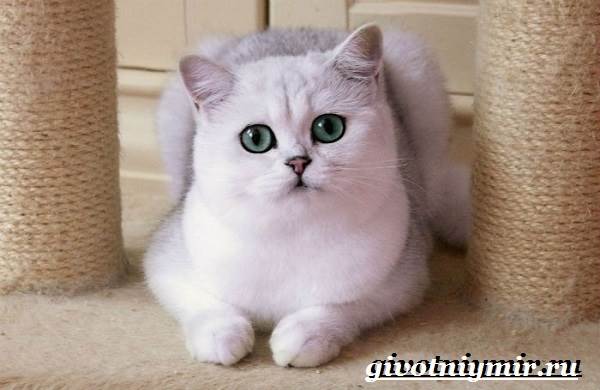
The nature of the pet with such outstanding data is appropriate. This is truly an aristocrat among the household. Tranquility and imposing - that's probably how briefly you can formulate the main features in behavior. No wonder the silvery lived in the apartments of Princess Victoria, which partly served as a surge of their popularity throughout the world.
Silver chinchilla - cat completely self-sufficient. She easily endures long hours of loneliness and is ideal for people who, due to their employment, are rarely at home. Unobtrusiveness inherent in this breed will be appreciated by many feline lovers.
However, the owner's attention, when he is at home, is very important for her. Chinchilla likes to get on her knees and pomurlykat when her favorite hands are stroking her soft fur coat.
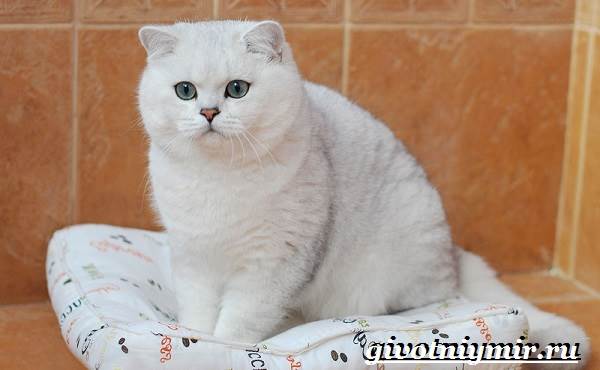
This breed is distinguished by enviable silence, and also with angelic patience. these are absolutely not conflict, so it is possible to keep them together with other cats and dogs, as well as in families where there are young children. With excessive attention from the master's offspring, the chinchilla acts wisely, instead of aggression, she simply prefers to retire.
Independence and stubbornness (in a good sense) is also an inalienable feature of the breed. A cat of silver chinchilla you can not force anything to do if he does not like it. But, however, it is in the nature of any cats. How is Kipling? "I am a cat, I walk by myself" - this is inherent in their nature.
Suffice it painful to endure the restriction of freedom or intrusion into personal space. A cat must have a corner where she can retire and have a rest.
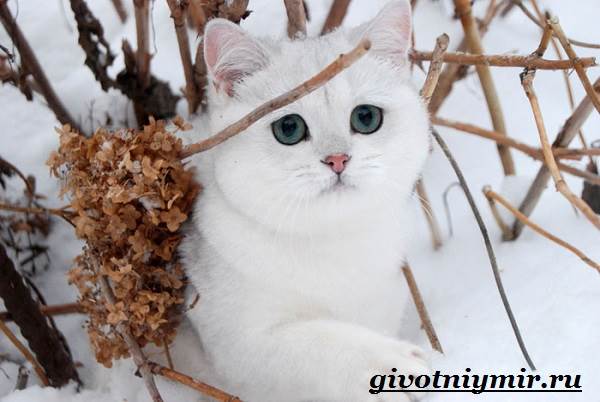
The intelligence and intelligence of chinchillas sometimes amaze even inveterate cat-owners. For example, a cat of this breed does not come to mind waking the owner on a day off, tickling his heels sticking out from under the blanket, or yelling furiously to be fed.
Many owners understand what is at stake. Chinchilla will sit down and wait patiently for the awakening of her Man. They are easy to learn and remember once mastered throughout their cat's life.
As well as it is necessary to aristocratic persons, representatives of the given breed extremely like to pose, colorful photo of silver chinchilla can be found on the pages of many famous publications. Although photos, even the most successful, can not at least partially convey the delight of personal experience with these fluffy intellectuals.
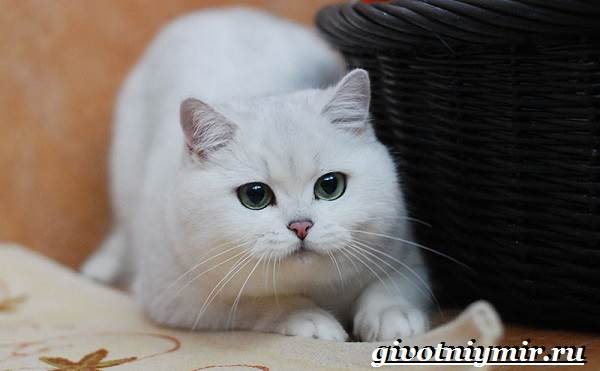
Description of breed silver chinchilla (requirements to the standard)
According to the adopted standard color of silver chinchilla mostly white. Wool can have a darker shade closer to the tips, not exceeding 1/8 of its length. It is because of this feature in the color, it seems that the fur of the chinchilla is cast by silver.
Eyes of greenish-blue tones, there are also cats with amber-green eyes. The body is strong, with a broad chest, thick short paws and tail. The head is round in shape with powerful cheekbones and small, trim ears. The nose of the chinchillas is wide, flat, slightly snub-nosed, colored, usually in a pink-brick color.
Persian silver chinchilla is famous for its long luxurious fur coat, very similar to. The eyes, brought in by black, are painted in a deep emerald color. Lips and cushions of paws are black, the nose is brick red.
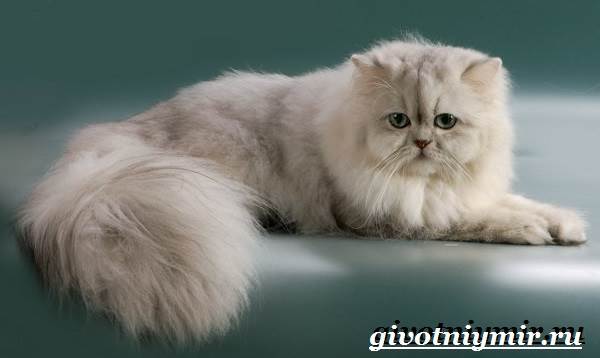
In the photo the cat is a Persian silvery chinchilla
British silver chinchillas are distinguished by a thick short fur, a muscular body with short, powerful paws. As with other varieties of chinchillas, British color is predominantly white with a dark bloom. Eyes are green, in a shaded British chinchilla they have a dark bezel.
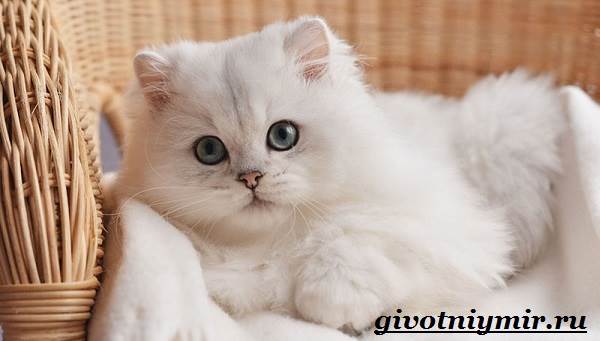
In the photo the British silver chinchilla
Scottish silver chinchilla externally very similar to the British: the same white undercoat and dark ends of wool. , having Scottish and British roots, are distinguished by good health.
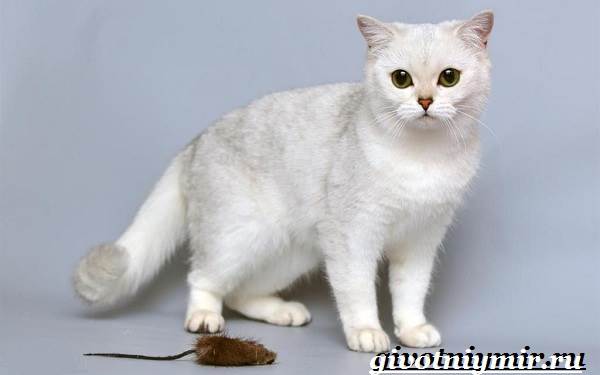
Cat scottish silver chinchilla
Separately I want to mention lop-eared silvery chinchillas. As a matter of fact it is the Scottish and British bloods possessing a traditional color for chinchillas.
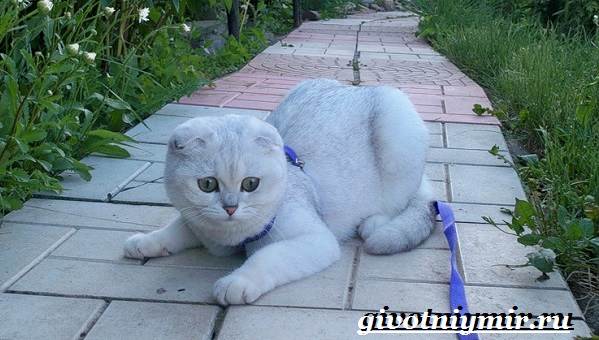
In the photo, a lop-eared silver chinchilla
Care and maintenance of a silver chinchilla cat
If you do not comb the chinchilla properly, when licking the wool gets into the digestive tract of the cat, fall into a lump and can cause a noticeable harm to the health of the pet.
Swimming silver chinchilla tolerates peace, water does not cause her panic. In addition to wool, it is necessary to monitor the teeth and condition of the auricles. To remove the plaque on the teeth in the cat diet should be present solid food.
Like everyone else, a silver chinchilla should undergo an annual vaccination procedure. Many people are of the opinion that this is not necessary if the pet does not go outside the apartment, however, dangerous for the cat viruses can easily be brought from the street along with dirty shoes.
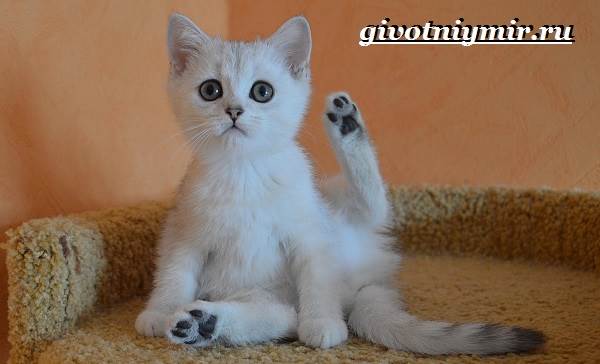
Price and reviews of the owners
To get kittens is better in large nurseries, whose owners will further advise on care and any possible problems. Price silver chinchilla depends on the purpose of the acquisition.
Kitten pet-class, bought only as a pet, will cost about 30 thousand rubles. Such kittens in the future are not used in breeding and do not pretend to show career, because they have minor deviations from the standard.
Breed- and show-class will cost more - in 50-70 thousand. Kittens of foreign producers are especially appreciated, but they are mainly bought by breeders in order to improve the breed.
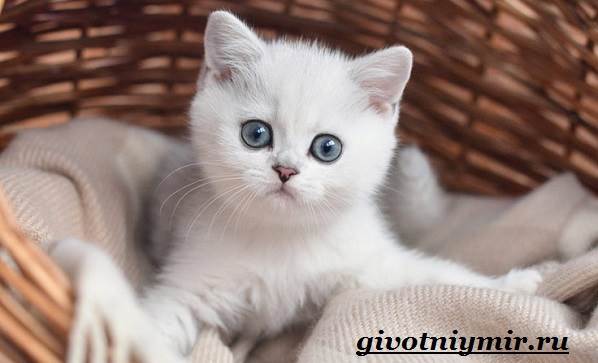
On the photo a kitten of silver chinchilla
People who once decided buy silver chinchilla, most likely, will remain true to this breed for the rest of their lives.
Finesse and innate grace, sensitivity and majestic calm, mind and beauty - that's how their owners speak of silver chinchillas. These are ideal companions, combining the best qualities of their family members.
A well-known cat of the breed, the British chinchilla, earned universal love and popularity in a relatively short period of time. The justified reason for this is the refined kind of animal, as well as the grace and plasticity of this creature. It is unlikely that there will be a person who can remain indifferent to the amazing beauty of a British cat. Strictly speaking, because of this popularity, we want to consider this kind of animals today. We will discuss the origin of the British chinchilla breed, its character, and also talk about the peculiarities in keeping such animals.
In the picture the British chinchilla
Breed Overview
Many, when they hear the name "British Chinchilla", for some reason immediately remember the American little rodent, known to the whole world. And, it's not accidental. After all, the animals of the chinchilla exist on earth for a long time, but cats with the same breed name do not so happy the world with their presence for so long.
The breed of British chinchilla appeared not so long ago, but in such a short time it deserved universal love. These animals delight the world with their exquisite, aristocratic appearance. Strictly speaking, because of this, the British cat wants to see firsthand, and even more to stroke her soft and silky fur coat. The photo below conveys the irresistible beauty of the breed of British chinchilla.
At once it is necessary to say that such cats appeared in our world not by chance. The breeders of cats of the British chinchilla were trained by experienced breeders. And, it is worth noting that the idea of these scientists has turned out well, because these animals are favorites all over the world. They even shoot for the most elite magazines about animals. British cats rightfully take prizes in a variety of competitions for pets of a world-class level.
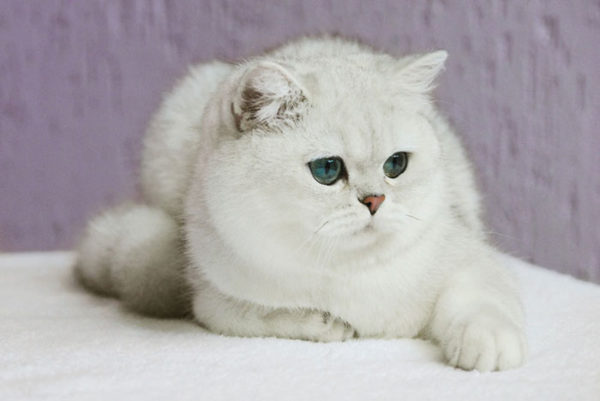
Origin
From the very name of the breed it is clear that the British cat was bred in the UK. To obtain this species, the best breeders of the country repeatedly crossed the best animals. In the process of reproduction, such cat breeds as Persian and Smoky British were involved. As a result, they got a new look. The British chinchilla inherited only the best from its ancestors. Thanks to the ancient roots of a kind, these cats have excellent health, the ability to perfectly adapt to a variety of climatic conditions. And, naturally, it was from his ancestors that the Briton received a unique hair color, as well as the length and thickness of the coat. Unfortunately, the scientists were not entirely satisfied with the appearance of the British chinchilla. There is a logical question: what exactly? Breeders did not like the green color with a yellow tinge of the cat's eyes. Scientists expected to receive eye color the same as that of ancestors, turquoise green. That is why the work on breeding the breed did not stop. True, one of the original breeds was new, only the Persian cats, Tabbi, were added to it. Polled version of the scientists demonstrated in the late nineteenth century. And, only through a century, they officially recognized the existence of this breed, and registered it. The first representative of the British silver chinchilla breed is a kitten with the nickname Silver Lambkin. No sooner had people become used to him, as he began to occupy the first places in all feline exhibitions.
So we disassembled the meaning of the word "British" in the name of the breed. But the second - "chinchilla", yet. This part of the cat received in its name from a unique resemblance to a furry animal with that name. The fur of this breed and the animals of chinchillas is very similar.
There is also a close relative of a silver cat. This is the British gold chinchilla. To deduce this breed, scientists used the same method as the original one for the basis. True, the basic species were silvery kittens.
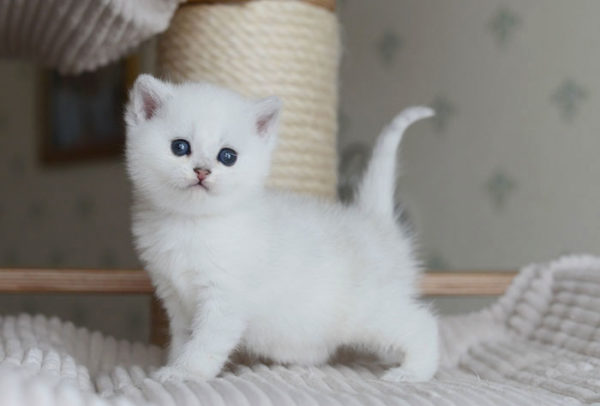
Description of the appearance
Cats of breed British chinchilla can be of several colors. Strictly speaking, because of which the following subspecies appeared:
- golden chinchilla;
- british silvery;
- tikirovannaya or shaded chinchilla.
- smoky.
Also, the color of British cats can be creamy and smoky. More rarely you can find this breed with such colors:
- tortoiseshell;
- bicolor;
- tabby;
- marble;
- harlequin;
- point;
- cinnamon.
Above mentioned color is very rare, actually, because of what animals in these colors are appreciated even higher. The fur of a real thoroughbred british, most often, monophonic, without any impregnations. The combinations of light shades with darker in the region of the legs and spout are acceptable.
The exception is a British cat in a golden fur coat. The color of such a beauty is far from monophonic. The back, sides and tail are much darker than the abdomen, neck and chin.
In the photo below, you can see the beautiful chinchilla in the color point.
Also it should be noted, in cats of this breed, eyes. Although the breeders, and were not happy with the color, but still unique. Reminiscent of the eyes of British breed cats is the purest emerald in a dark frame. After all, these animals have a black border around their eyes, which makes them more expressive.
Representatives of this breed have a well-developed physique. They have a fairly wide neck. The back of British cats is equal, not very long. The breast is properly folded. The paws of the British chinchilla are very strong and massive. In addition, the tail of this breed is very large and wide, slightly curled at the end.
Also, according to external data, not only colors are distinguished, but also the length of the wool. On this basis, all the animals of this species share the following subspecies:
- British long-haired chinchilla;
- British coatshirt.
Still these groups differ not only in their length of hair, but also in the fact that in the second species the color of the coat is much brighter and more saturated than in the first.
Cats of this breed are very beautiful, in no matter the color. But, the golden color of fur, gives these animals a real gloss and uniqueness. The wool of this subspecies is poured. Each hair is painted in its own individual color, which creates a unique picture, painted by nature.
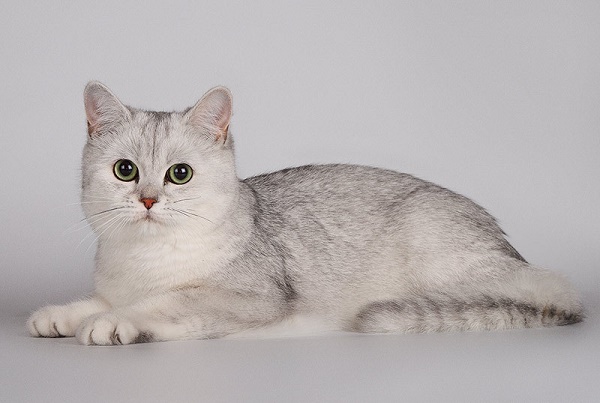
Nature of the breed
Animals representing this species have aristocratic manners. They are quite calm and patient. British cats do not scratch furniture, do not meow loudly. They behave very quietly, waiting for attention from their master. This breed is recommended to start in homes with young children. The British chinchilla will never harm a child.
If you offend such an animal, it will not take revenge, but with pride leave, and will no longer pay so much attention to you.
You can not punish the British cats, because they do not like it. Although, unlikely, there is a reason for such an act. Cats of chinchilla are very obedient and not spoiled.
To be honest, to win the true love of such handsome people, it is necessary to work hard, apply love and affection towards the pet.
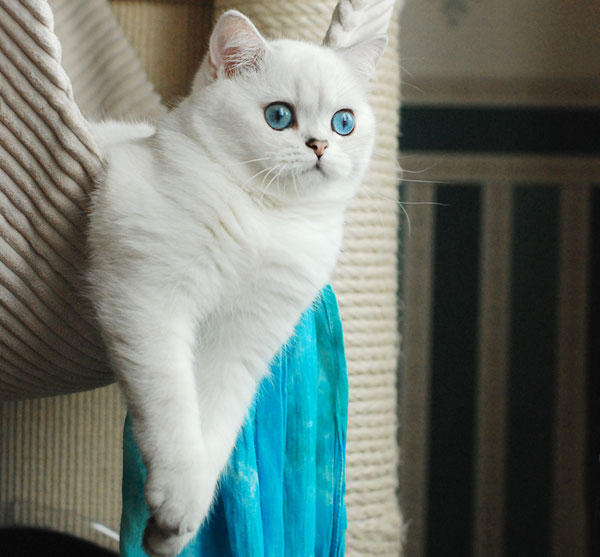
The contents of the British chinchilla at home
In this issue, there will be no difficulties. Cats of this breed are not demanding in care. Small kittens are quite easy to accustom to the tray, even in early childhood.
Fur does not need constant combing. It is by nature very soft and silky, it does not fall out and rolls into lumps. In this matter, you just need to adhere to the basic conditions of animal hygiene. In time, he bathe, and comb the hair from time to time. At least twice a week.
It is desirable to provide the Briton at home with his place where he can sleep, rest and play. These animals are very freedom-loving, and do not like when outsiders encroach on their territory.
Most often, British chinchilla cats are kept at home, with the aim of participating in all sorts of exhibitions. Because these animals are the best in this matter. However, in the period before the contest, special attention should be given to the appearance of cats. It is good to buy them, perhaps, to use special means to care for the wool of these animals.
Also, pay special attention to the eyes of cats. Very often the organ of vision in this breed can be watered, due to various factors such as hot weather. At this moment it is necessary to help the animal. You can soak your eyes with a cotton swab with a solution of boric acid, only not strong. If worsening, you should immediately contact a veterinarian.
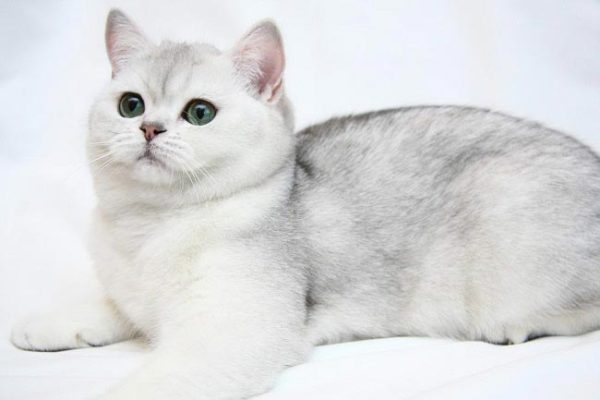
Food
Cats of British chinchilla breed need proper nutrition. You need to monitor the diet of your pet. Food should be varied and useful. You can give food cooked at home or purchased at special stores. It is advisable to adhere separately to nutrition, in time to notice if a product does not fit the animal.
Chinchilla cat likes to eat meat, fish, dairy products, as well as vegetables such as carrots and cabbage.
As you can see, the British cat is very beautiful and kind animal, which can not only give you pleasant emotions, but also bring not a small income. Especially if you purchased an animal in color point or marble. These colors are considered the rarest and unique, and accordingly, and costly.
Chinchilla is without a doubt one of the most beautiful cats, and it's no wonder that these magnificent creatures are called royal Britons. Even in the photo the chinchilla makes an indelible impression, and the amazing beauty of these amazing cats can not leave anyone indifferent.
History of origin
For the first time cats of chinchilla appeared in Britain in the eighties of the nineteenth century. And the story of these animals began with a kitten having an unusual color of wool, which was born to an ordinary Persian cat. The baby was called Shina, and she so impressed the breeders with a unique color that they decided to work hard to bring out a new breed.
As a result of painstaking work on crossing the descendants of Shina with thoroughbred British cats, a new breed appeared, with a long, shimmering hair. At first, the kittens were born with darker colors, more reminiscent of gray - blue British, but over time breeders managed to bring out cats, with a lighter, pearly - silvery color of wool.
A detailed description of the breed of these cats, as well as the official recognition of "British aristocrats," occurred many years after the appearance of the first kitten of the chinchilla, only at the end of the twentieth century.
The breed of chinchilla cats to this day is the cause of disputes between many experts. Some do not recognize these magnificent beauties as an independent breed, and consider them a special subspecies of long-haired Persians.
Description of the appearance
Although chinchillas at first glance appear large and bulky animals, this impression is created solely at the expense of long wool:
- These are medium sized cats, weighing not more than seven kilograms. Females, like most felines, are slightly smaller than males, and weigh no more than five kilograms.
- Chinchillas have a large and squat physique. They have a body with soft smooth outlines, a broad chest and straight straight back.
- Paws in cats are short and thick. The paw pads are wide, round in shape. Between the fingers on the pads of the paws there are tufts of wool.
- The tail of the chinchillas is one of the distinguishing features of these cats. A short and rather thick tail along the entire length is covered with a long and luxurious coat, which gives it a resemblance to a fan.
- The head is of medium size, round in shape, with a soft and short chin.
- The nose is small and broad, slightly flattened.
- Ears are small, with rounded tips. The inner side of the ears is covered with thick wool, while long-haired individuals have tassels on the tips of the ears.
- Expressive, huge and brilliant eyes of these cats immediately attract attention, first of all, thanks to an unusual shape. The eyes of the chinchilla have an oval shape, and the outer corners of the eyes are slightly lowered down, which gives the cute round muzzle of the animal a slightly offended and touching appearance. The color of the eyes is usually bright green, but for some representatives of this breed the eyes have a grayish-bluish tinge.
- The wool of cats is long and dense, with a thick undercoat. On the neck of cats there is a chic collar.
- The color of cats should be given special attention. Although these cats are named as South American rodents, these animals have nothing in common with these chinchillas. Color cats chinchilla got its name because of the unusual structure of the shade of the coat. Fur in animals closer to the body has a light color, which gradually darkens to the tips of the coat. Thanks to this feature, the fur coat of cats seems shimmering and iridescent.
![]()
Chinchill in color is divided into three categories:
- Silvery.
- Silvery shaded.
- Golden.
Characteristics of character
A chinchilla cat has a friendly and accommodating nature. This cat quickly becomes attached to the owner and requires special attention. A favorite place for these fluffy creatures is the knees of the beloved master, where cats can pour all their love and tenderness on him for hours in a melodious purr.
To the guests of the cat are treated with full confidence, and will gladly allow themselves to stroke and pick up. With the rest of the animals in the house, the chinchilla behaves in a friendly manner, but does not have a special friendship with them.
Kittens of this breed are playful and curious, and with delight will play with a paper bow or a plush mouse. But with age, the chinchilla turns into a sedate and calm animal, full of a sense of royal dignity. These cats always prefer to luxuriate on a soft armchair or a warm window sill, and not to run after a toy or a ball thrown by the owner.
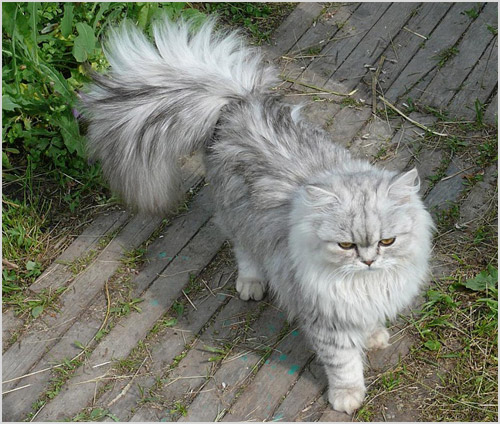
Like their relatives, Persian cats, chinchillas require thorough and thorough care:
- The long and luxurious coat of these cats is often tangled because of the thick undercoat, so it needs constant combing. Combing pets should be no less than once every two days, otherwise you will have to cut off the koltuns, which will significantly spoil the appearance of the animals. Comb the cats first in the direction of growth of the coat, and then against the coat.
- Chinchilla reluctantly allows herself to bathe, as these cats are afraid of water. A good way out for owners of these "royal persons" can be a special dry shampoo for cats, which should not be washed off with water. Use this shampoo should be every two weeks.
- Ears in frequent care do not need, it is enough to wipe them with a cotton swab once a week.
- But the eyes of cats are prone to increased lacrimation, so it is recommended that they be regularly wiped with a soft moistened napkin.
Health
Cats of chinchilla are considered healthy and hardy animals. But still there are diseases to which they are exposed. First of all, it is hypertrophic cardiomyopathy and polycystic kidney disease. Also, cats can have problems with their teeth, so they should be cleaned regularly.
Feeding
The owners of these animals are also concerned with the question: what to feed the cat to the chinchilla? Since chinchillas are inactive animals, they are prone to obesity, so the food for them should be low-calorie and balanced. Fodders for furry cats that already contain all the necessary vitamins and trace elements for the beauty of their wool are best suited.
If preference is given to natural foods, then fatty fish and meat should be avoided. It is best to feed cats with meat of poultry, veal and rabbit, by-products and fermented milk products.
Acquisition of the kitten
Fans of these amazing animals often ask: how much does a chinchilla cost? The price for these cats varies from five to fifty thousand rubles. Buy a chinchilla cat can be in the nursery or a private breeder, and its cost will depend on the history of the pedigree, the availability of documents and color.
Chinchilla will be an excellent pet for people who appreciate peace and quiet. These amazing and charming creatures are worth to be surrounded by care and attention, and they will necessarily answer with infinite devotion and love.

